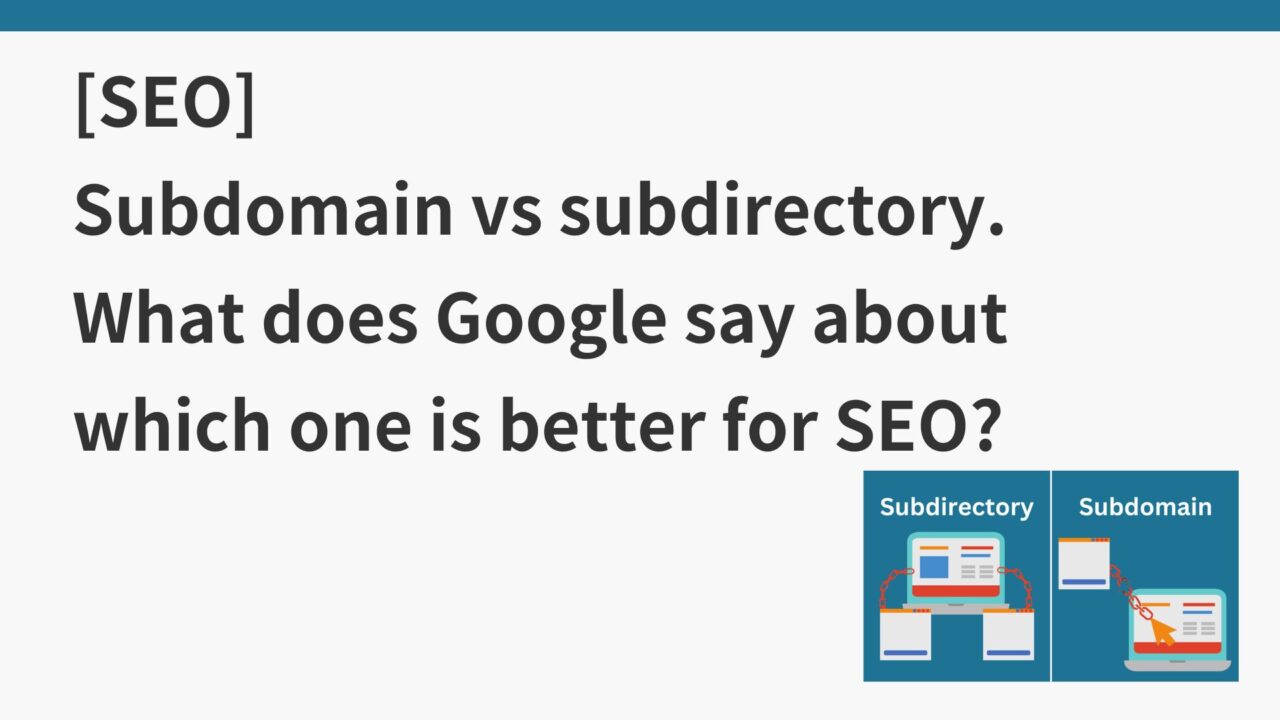Introduction
The question of whether subdomains or subdirectories are better for SEO may be an everlasting topic. Here’s a summary of how these choices affect SEO and Google’s opinion.
What are subdomains and subdirectories?
sub domain
- A domain with a new string added before the original domain (e.g. subdomain.example.com )
subdirectory
- A domain with a new string added after the original domain (e.g. example.com/subdirectory )

Subdirectory > subdomain? Distribution of domain authority
The article below recommends subdirectories from the perspective of distributing domain authority and concentrating keywords.

Distributing domain authority
- By using subdirectories, you can inherit authority from the main domain. All subdirectories are considered part of the main domain, so they share the same credibility and rank as the main domain. There is less variance in link juice (SEO value gained from backlinks).
- On the other hand, subdomains are considered independent, so link juice from the main domain may not flow directly to the subdomain or may not be as strong as it is for subdirectories.
Concentration of keywords
- A subdirectory strategy concentrates keywords on a single domain, while a subdomain strategy spreads keywords across multiple independent domains. This makes the root domain more authoritative when using subdirectories.
Let’s compare an example of a website structure aimed at promoting sales of a certain SaaS product using a subdirectory strategy and a subdomain strategy.
Website for promoting SaaS products: For subdirectory strategy
Website structure:
- Product purchase page:
example.com/product- Keywords: online collaboration tools, SaaS product purchases, team collaboration software
- IT blog:
example.com/blog- Keywords: IT trends, SaaS product reviews, technology innovation
Advantages of the strategy:
- Internal links from blogs to product pages directly contribute to increasing the authority and visibility of the product page.
- When a blog gains external links, it strengthens the domain authority of the website as a whole and also helps improve product page rankings.
- Your SEO efforts will be shared across your website, leading to increased traffic to your product pages.
Website for promoting SaaS products: In case of subdomain strategy
Website structure:
- Product purchase page:
product.example.com- Keywords: online collaboration tools, SaaS product purchases, team collaboration software
- IT blog:
blog.example.com- Keywords: IT trends, SaaS product reviews, technology innovation
Strategy advantages and limitations:
- Even if a blog (
blog.example.com) acquires high authority, that authority is mainly valid only within the blog andproduct.example.comdoes not directly contribute to improving its authority. - Links between blogs and product pages improve the user experience, but don’t provide the same SEO benefits as a subdirectory strategy. This is because search engines tend to treat subdomains as independent entities, so they are treated similarly to links from external sites, and links within the same domain (for example, links
example.com/blogfrom toexample.com/product) convey stronger domain authority. Because it is not expected. - SEO strategies need to be developed independently for each subdomain, which spreads out the effort.
We conclude that startups and small businesses should consider using subdirectories if they want to optimize their SEO. Unless you’re a large company or just finished raising a Series C round, subdomaining your site into many silos won’t help your SEO.
Is it true?
What does Google say?
By the way, Google has made it clear that subdomains and subdirectories are equivalent in the eyes of Google Bot. In other words, subdirectories and subdomains are the same in terms of search result rankings.
This means that while treating subdomains as separate entities, proper internal linking can make it clear that the subdomains belong to the same website, and the relationship between the main domain and its subdomains. This means that Google’s algorithm has evolved to be able to identify and recognize .
Is a subdomain good when expanding into overseas markets?
For example, if you are a US-based company and your website was originally built in English, but you decide to expand into the German market and want to offer content specifically for German-speaking users, you may want to .
First, since English keywords do not rank high in German searches, is it better to translate the site into German and build a new German-oriented site from scratch as a subdomain?
This cannot be generalized either.
Recently, automatic translation plug-ins (such as WordPress) have advanced, so the strategy of using subdirectories to display content in that language when visited from a browser in a different country is an efficient way to run multilingual sites. Suitable if you want to operate the
conclusion
There is no body or cover, but neither is relevant in terms of SEO. However, from the perspective of ease of operation, it may be easier to use subdirectories.



コメント